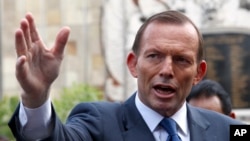Australia on Thursday released a draft climate plan that would leave the government responsible for funding the nation's emission cuts while the nation's biggest carbon emitters would only be liable if they exceed historically high levels.
The A$2.55 billion Emissions Reduction Fund is the Liberal government's main weapon to meet its target of cutting Australia's climate-changing emissions to 5 percent below 2000 levels by 2020.
Australia must cut CO2 emissions by 421 million tons between now and the end of the decade to meet the target.
“It is a practical policy that will reduce Australia's emissions at low cost, without adding to household and business energy costs,” read the plan, launched by Environment Minister Greg Hunt.
Thursday's plan outlined rules for how the fund would spend A$1.55 billion over the next three years and a further billion later to buy emission reductions from companies that offer the cheapest cuts through government auctions.
Environment Minister Hunt told a press conference in Canberra the fund would ensure Australia easily meets its 2020 target, although most independent analysis have shown it will fall well short of achieving the 5-percent cut unless it allocates several billion dollars more to the fund.
“The best way to guarantee that the ERF can meet the target, stay within its budget and avoid imposing new red tape would be to expand the policy to include low-cost international carbon credits,” industry lobby Ai Group said in a statement.
The government plans to fund the plan through the budget in the coming weeks, but it remains uncertain if it will be able to launch it, after the Palmer United Party, which will hold the power of balance in the Senate from July, said earlier this week it would block the policy.
According to the plan, companies under the nation's 2010 emissions reporting scheme would be given an emissions cap, or a baseline, equal to their highest historical emission levels.
There would be no demand for companies to reduce their carbon dioxide emissions over time.
In order to ensure that emitters don't exceed their caps, the government said it would introduce “safeguard mechanisms” from July 2015.
The safeguards, or punishments, were not defined, but are expected to include the option to buy credits from emission-cutting projects to make good for excessive emissions.
However, only facilities emitting 100,000 tons of CO2 or more per year - equal to 52 percent of Australia's total carbon output - would be subject to punishment, the plan said.
“Smaller businesses... will not have a baseline and can presumably emit more without consequence,” said Bret Harper, a carbon analyst with consultancy Reputex.
The plan maintained the government would only fund projects by buying their emission cuts for a five-year period, despite critics arguing that five years is too short to fund capital intensive or long-term projects.
But the government on Thursday said it would “undertake market testing of contractual terms” to see if contract lengths might be extended.
The A$2.55 billion Emissions Reduction Fund is the Liberal government's main weapon to meet its target of cutting Australia's climate-changing emissions to 5 percent below 2000 levels by 2020.
Australia must cut CO2 emissions by 421 million tons between now and the end of the decade to meet the target.
“It is a practical policy that will reduce Australia's emissions at low cost, without adding to household and business energy costs,” read the plan, launched by Environment Minister Greg Hunt.
Thursday's plan outlined rules for how the fund would spend A$1.55 billion over the next three years and a further billion later to buy emission reductions from companies that offer the cheapest cuts through government auctions.
Environment Minister Hunt told a press conference in Canberra the fund would ensure Australia easily meets its 2020 target, although most independent analysis have shown it will fall well short of achieving the 5-percent cut unless it allocates several billion dollars more to the fund.
“The best way to guarantee that the ERF can meet the target, stay within its budget and avoid imposing new red tape would be to expand the policy to include low-cost international carbon credits,” industry lobby Ai Group said in a statement.
The government plans to fund the plan through the budget in the coming weeks, but it remains uncertain if it will be able to launch it, after the Palmer United Party, which will hold the power of balance in the Senate from July, said earlier this week it would block the policy.
According to the plan, companies under the nation's 2010 emissions reporting scheme would be given an emissions cap, or a baseline, equal to their highest historical emission levels.
There would be no demand for companies to reduce their carbon dioxide emissions over time.
In order to ensure that emitters don't exceed their caps, the government said it would introduce “safeguard mechanisms” from July 2015.
The safeguards, or punishments, were not defined, but are expected to include the option to buy credits from emission-cutting projects to make good for excessive emissions.
However, only facilities emitting 100,000 tons of CO2 or more per year - equal to 52 percent of Australia's total carbon output - would be subject to punishment, the plan said.
“Smaller businesses... will not have a baseline and can presumably emit more without consequence,” said Bret Harper, a carbon analyst with consultancy Reputex.
The plan maintained the government would only fund projects by buying their emission cuts for a five-year period, despite critics arguing that five years is too short to fund capital intensive or long-term projects.
But the government on Thursday said it would “undertake market testing of contractual terms” to see if contract lengths might be extended.






